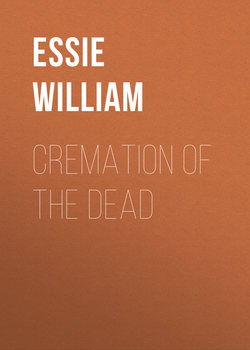Cremation of the Dead

Реклама. ООО «ЛитРес», ИНН: 7719571260.
Оглавление
Essie William. Cremation of the Dead
PREFACE
CHAPTER I. INTRODUCTION
CHAPTER II. METHODS OF TREATING THE DEAD
CHAPTER III. OUR BURIAL LAWS
CHAPTER IV. DANGERS OF OUR SYSTEM OF BURIAL
CHAPTER V. PRESENT STATE OF THE CREMATION QUESTION.117
CHAPTER VI. CREMATION, ANCIENT AND MODERN
BIBLIOGRAPHY OF CREMATION
Отрывок из книги
Cremation of the dead is neither new in theory nor in practice. In the England of modern times, however, the question has only recently assumed recognised importance. And the more one considers cremation, the more one finds himself wondering how it has come to pass that we practise burial, with its many faults, and do not burn our dead. Thousands amongst us are now beginning to feel thankful that the dead are soon to 'rule our spirits from their urns' in a realistic and not alone in a poetical sense. They think there is something majestic and even pleasurable in the idea that it will ere long be possible, on all civilised shores, to leave their mother earth, not with a partial, but with a fully consummated sacrifice upon her altar, bidding her adieu none the worse, but rather the better, for their sojourn with her. They groan and labour under the burden of enforced burial, and 'hail with satisfaction and joy the prospect that a chariot of fire may receive them instead of the cold and darksome grave.'
The scheme has met with some enemies, and injudicious promoters of the system have not proved the least of them. The idea that it was sought to make it compulsory, was an unfortunate utterance. The notion of producing illuminating gas for general purposes from the combustion of the bodies was another mischievous idea.1 Equally so was the proposal for the erection of a tall shaft in the cemetery grounds, where the gases could be seen consuming – something after the fashion, I suppose, of the twelfth century's lanternes des morts. The publication of crude and undigested fancies does more harm than good to the subject they are meant to benefit.
.....
People are every now and then solemnly informed that it is unadvisable to practise cremation because it is supposed to militate against a belief in the resurrection.21
But the ancient Romans, as has been explained by his Grace the Bishop of Manchester, believed in the immortality of the soul, which is a collateral idea, and they practised the burning of the dead. They did not believe in the resurrection of their present bodies, it is true, neither do many now.22 The truth, on examination, however, appears to be that the early Christians objected to it because it was practised by the pagans, and because it was necessary to draw a strong barrier line between the two faiths. The ostensible objection which they found to burning was that their bodies had been redeemed and renewed in God's image. They taught that it was unlawful to burn the dead, because the penalty of fire had been remitted. The body was to be buried, and was thus held to be in readiness for the last trump. They did not believe that it was impossible to raise up the martyrs which were even then burnt, but they were not to burn. The breach between the two faiths was not at first an utter one, however. The Christians interred in the same places as the heathens, and even painted and engraved upon the catacombs representations of the heathen gods and goddesses.23 The breach, however, widened, and then came the more Christian emblems of wreaths of flowers, angels, and children. Later on in succession came the Good Shepherd, the cross, the crucifixion scene, and so on,24 gradually leading up to the skull and cross-bones of the last century. By this time the Christians heard of burning with horror. But a classical reaction set in about the time of Pope and Dryden, and now again may be seen in every churchyard the broken shaft, the inverted torches, and other emblems. It would also be fairly impossible to count the number of marble urns which 'in pride of place' rest upon the monuments in our cemeteries.
.....